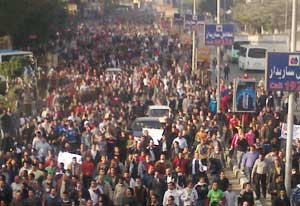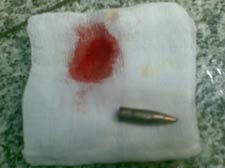Fogarty program saves lives amid Egyptian turmoil
January/February 2011 | Volume 10, Issue 1

Photo by M. Shinawi
Cairo protests caused casualties.
The recent political unrest in Egypt has thrust hundreds of thousands of demonstrators into the streets, changed the country’s government and shined a spotlight on an NIH-sponsored research training program that is credited with saving lives.
Dr. Jon Mark Hirshon of the University of Maryland’s National Study Center for Trauma and EMS has been working with Egyptian doctors for six years to build skills in injury prevention research. The program, administered by Fogarty, is a collaboration between UMD and Ain Shams University in Cairo and led to the development of a course for the care and evaluation of injured patients.
Hirshon said the program aided in the treatment and evaluation of the many injured who were seen at the hospital and, according to his Egyptian colleagues, was “incredibly helpful in saving lives during the turbulent past week,” he said in remarks first reported by MedPage Today/ABC News.
Dr. Mohamed Selim, a surgeon at Ain Shams - one of the two closest hospitals to Tahrir Square, the epicenter of the demonstrations - offered a vivid picture of events on Friday, Jan. 28, at the height of the turmoil.

Photo by M. Shinawi
Surgeons at Ain Shams Hospital near
Cairo’s Tahrir Square treated numerous
bullet wounds.
“We had a gush of gunshots, stab wounds, crashes, people hit by stones, a lot of post-concussions, a lot of mortalities, about 25 to 30 mortalities, and a lot of people admitted to the hospital,” he said. The emergency room at the hospital normally treats 20 to 30 patients; on this day there were more than 200.
When the crush hit the ER, Selim said the residents who had been through the course “were taking the lead during the mass casualties. They knew what to do - how to deal with the patients, how to triage them and how to manage them.
“And really they saved a lot of lives,” the surgeon said.
The Ain Shams hospital is a modern facility with well-trained doctors and staff, but they have been overwhelmed during the protests, Hirshon said. “But even in the U.S., if you’re getting hundreds of people injured, you’re going to be overwhelmed,” he said.
Selim said the program had prepared them well. “We were exhausted but we know we are doing something for our country, so we are proud of what we are doing,” he said.
More Information
To view Adobe PDF files,
download current, free accessible plug-ins from Adobe's website.
Related Fogarty Programs
Related World Regions / Countries
Related Global Health Research Topics